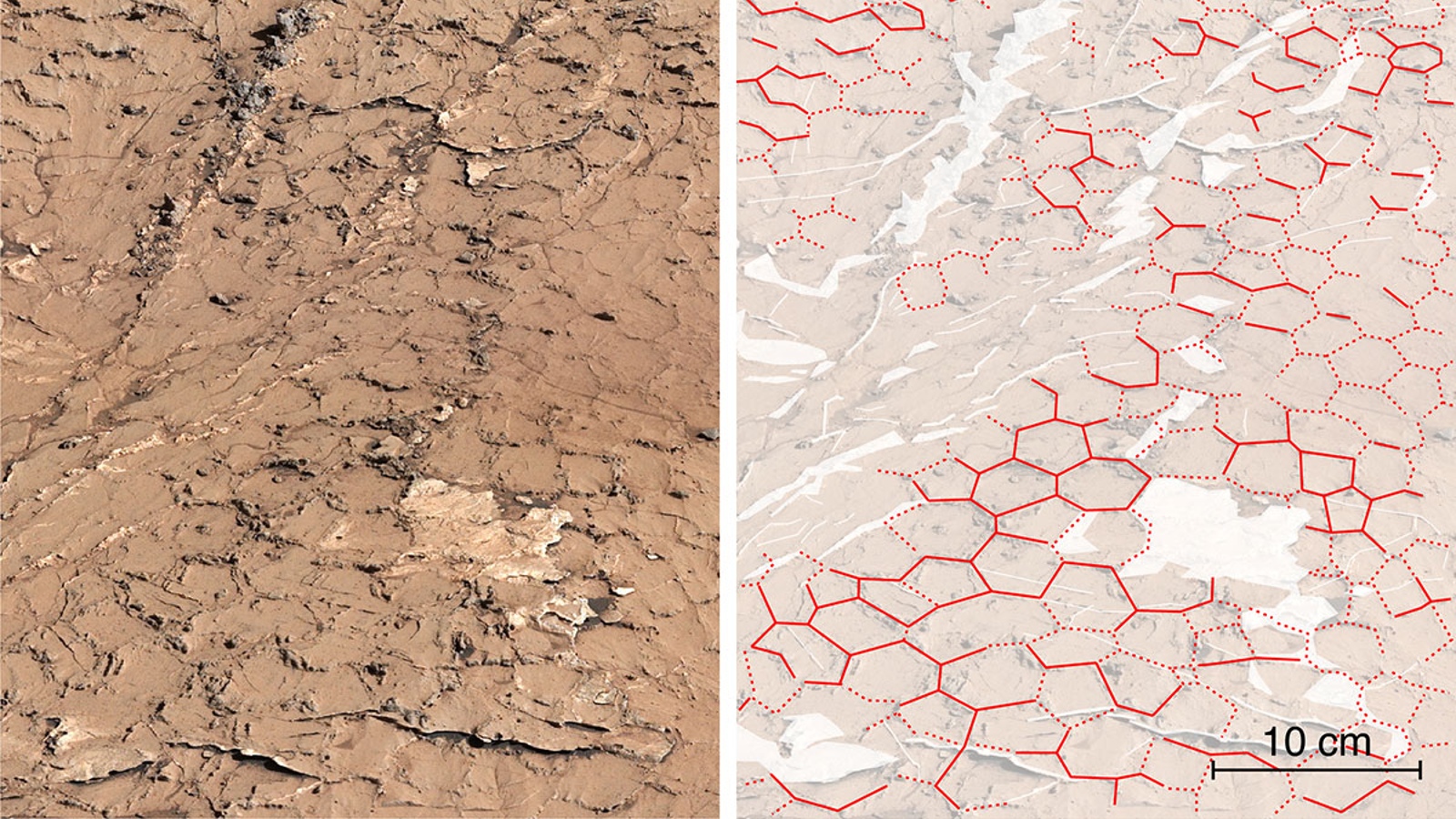Bizarre polygons on Mars' surface hint that alien life on Red Planet was possible
A patchwork of polygon-shaped cracks in ancient Martian mud are evidence of past wet-dry cycles, which could have helped extraterrestrial life emerge on the Red Planet.
A "patchwork of well-preserved ancient mud cracks" on the Martian surface hints that past extraterrestrial life on Mars was possible, a new study reveals.
In 2021, NASA's Curiosity rover snapped pictures of the polygonal shapes on the slopes of Mount Sharp, a peak that stands 3 miles (5 kilometers) high in Gale Crater — the large depression where Curiosity first landed in 2012 and has spent the entirety of its mission. The shapes, which mainly have five or six distinct sides, date to between 3.8 billion and 3.6 billion years ago.
Researchers initially identified the shapes as mud cracks, which was further proof that Mars was once a much wetter planet. But in a new study, published Aug. 9 in the journal Nature, researchers reanalyzed the markings and found that they were formed during wet-dry cycles, similar to the seasonal cycles on Earth, which, until now, had not been previously known to occur on Mars.
"This is the first tangible evidence we've seen that the ancient climate of Mars had such regular, Earth-like wet-dry cycles," study lead author William Rapin, a planetary scientist at the National Center for Scientific Research (CNRS) in France, said in a statement. "But even more important is that wet-dry cycles are helpful — maybe even required — for the molecular evolution that could lead to life."
Related: Curiosity rover discovers that evidence of past life on Mars may have been erased
The mud cracks were discovered in a region above a clay-rich redeposit, which was once the bed of an ancient lake, and below an area rich with sulfates, which are left behind as water dries. This initially suggested the mud cracks were created when the ancient lake dried up. Curiosity previously discovered similar T-shaped mud cracks in 2017 at a site nicknamed "Old Soaker" close to where the new cracks were discovered, according to NASA.
But the newer cracks have traces of sulfates, which suggests that they had dried out multiple times as they were created, meaning they were made during a time where the level of water in the lake continually rose and fell. This also explains why these cracks have a polygonal shape compared to the T-shape of the Old Soaker cracks. As the same types of cracks formed repeatedly, they morphed into a more complex shape, the researchers wrote.
Get the world’s most fascinating discoveries delivered straight to your inbox.
Similar wet and dry cycles on Earth are one explanation for how organic compounds — molecules containing carbon and other elements that are found in all living organisms — first emerged, the researchers wrote in the statement. Constantly changing conditions can continually alter the available chemicals in the environment, thereby encouraging chemical reactions in which polymers, or chains of molecules, grow into organic compounds such as nucleic acids, or the precursors to DNA, they added.
Mars rovers have already discovered organic compounds in a range of different Martian rocks. Scientists have also found these compounds hiding inside Martian meteorites that have crashed to Earth. But natural geological processes can also create these compounds, and asteroids also carry them, which suggests they may have crash landed on the Red Planet. All this makes it hard for scientists to link the compounds to extraterrestrial life
But the discovery of wet-dry cycles has now revealed a natural process that could not only explain how these organic compounds were created but also how they may have "promoted the origin of life," Ashwin Vasavada, a scientist at the Mars Science Laboratory at NASA's Jet Propulsion Laboratory in California who was not involved in the study, said in the statement.
This is not the first time that strange polygons have been spotted on the Martian surface. In March 2022, much larger polygons with white outlines were photographed from above by NASA's Mars Reconnaissance Orbiter. These puzzling shapes were created by hidden reservoirs of ice butting up against the Martian surface.

Harry is a U.K.-based senior staff writer at Live Science. He studied marine biology at the University of Exeter before training to become a journalist. He covers a wide range of topics including space exploration, planetary science, space weather, climate change, animal behavior and paleontology. His recent work on the solar maximum won "best space submission" at the 2024 Aerospace Media Awards and was shortlisted in the "top scoop" category at the NCTJ Awards for Excellence in 2023. He also writes Live Science's weekly Earth from space series.




